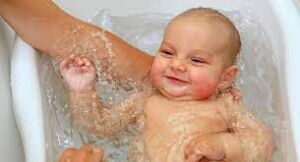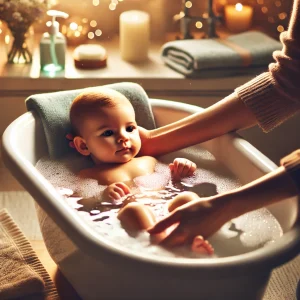Bathing a Baby: What You Need to Know for Cleanliness and Comfort
Bathing is an essential part of our daily routine, yet it is often overlooked and taken for granted. Have you ever stopped to think about the benefits of taking a bath or shower? Bathing a baby is a key part of their care and hygiene routine. It not only keeps the baby clean but also provides an opportunity for bonding, relaxation, and skin health. From relaxation to hygiene, there are numerous reasons why we should prioritize this daily ritual. In this section, we will explore the importance of bathing of the newborn baby. So, grab a towel and let’s dive in! Please keep reading for details on the following topics:
Overview of bathing of the newborn
How to bathe a baby

OVERVIEW OF BATHING OF THE NEWBORN
Newborn babies are bathed to prevent transmitting certain infectious diseases acquired from the mother’s amniotic fluid
The waxy white substance found covering the skin of newborn babies is called vernix caseosa and should not be washed off because it moisturizes the baby’s skin and prevents infections
Babies may be bathed about three times weekly to prevent the skin from getting too dry, sponge baths may be given
Wait until the stomach settles to bathe baby to avoid drowning
Avoid leaving baby unattended in the water, to avoid rolling, falling or drowning
In order to maintain baby’s warmth, be sure to expose only the parts of the body being washed
Dry each area immediately after they are washed to prevent heat loss
Keep one hand on the baby at all times for support.
Avoid using too much soap, as it can dry out the baby’s skin.
Ensure the room is warm to prevent the baby from getting cold.
Use only baby-specific products to protect sensitive skin.
Types of Baby Baths
- Sponge Bath: Use a soft washcloth to clean the baby’s face, neck, hands, and diaper area.
- Tub Bath: Once the umbilical cord stump has healed, you can use a baby bathtub or a clean sink.
How Often to Bathe a Baby
- Newborns don’t need daily baths. 2-3 times a week is enough as long as the diaper area is cleaned thoroughly during diaper changes.
- Older babies can be bathed more frequently, especially if they start crawling or eating solids.
Preparing for the Bath
Before starting, gather all the necessary items to ensure safety and convenience:
- Baby bathtub or clean sink.
- Warm water (about 37-38°C or 98-100°F).
- Baby soap or shampoo (mild and fragrance-free).
- Soft washcloth or sponge.
- Hooded towel.
- Clean diaper and clothes.
HOW TO SPONGE BATH A BABY
- Lay the baby on a flat, safe surface (e.g., a changing table or bed) with a towel underneath.
- Use a damp washcloth to clean the baby’s face, focusing on the eyes (wipe outward) and behind the ears.
- Gently clean the rest of the body, paying attention to folds in the neck, arms, and legs.
- Clean the diaper area last with a separate cloth.
HOW TO TUB BATH A BABY

Ensure that the room is warm and free from air currents such as an opened window, air conditioning or fan
Select a flat surface such as a countertop or the floor and covered with a towel
Gather all supplies needed such as fragrance-free soap, clothing, wash cloth, diaper, wipes, blanket and basin
Fill the baby bathtub with about 2-3 inches of warm water
Use your elbow or a thermometer to ensure the water is comfortably warm, not hot.
Wrap baby in a towel and lay him/her on the flat surface, on the back
Using only plain water, wet and squeeze the washcloth and clean the eyes from corner to corner
Pat the eyelids dry
Clean the mouth, then the face and ears
Clean the exterior part of baby’s ears with extra caution to avoid water from entering the ears, pat dry
With gentle care, being sure to block the ears to prevent water from entering the ears, bend baby’s head over the water and wash the hair, pat dry thoroughly
Wet hands and apply soap to same
Rubs hands together to make a soapy lather
Rub the soap all over the baby’s body: to the creases under the arms, around the neck and over the chest and back, over the buttocks, around the legs and between the toes
Whilst supporting the baby’s head and neck with the nondominant hand and the body with the dominant hand, place baby into the bath, feet first, to rise out the soap
Keep baby’s head and neck above water at all times to avoid drowning
Transfer baby from the water to a clean towel and pat dry thoroughly
Dress baby by placing the pamper then hat, vest, socks and the remaining clothing
Disclaimer: The information provided in this content is for general informational purposes only. It is not intended as medical or healthcare advice, diagnosis, or treatment. Always seek the advice of a qualified healthcare professional with any questions you may have regarding a medical condition or healthcare decisions.

